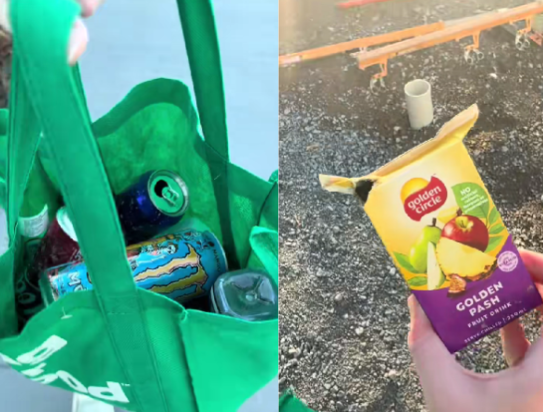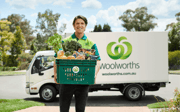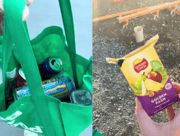
There’s something thrilling about stumbling upon unexpected money, but what if you could find it every single day?
For Queensland’s Amy Coulston, that became reality when she turned her dog walks into profitable treasure hunts.
By simply picking up discarded bottles and cans, she earned more than $420.
Her story came at the perfect moment for older Australians, as the country reached a milestone on 1 May 2025.
With Tasmania launching its ‘Recycle Rewards’ program, Australia became the first continent fully covered by container deposit schemes.
This meant every household could transform empties into income—10 cents at a time.
Coulston said she never had a grand plan when she began collecting, only the realisation that money was being thrown away.
She carried a bag on her daily walks and discovered that construction sites were hotspots for discarded cans and bottles.
Her efforts not only filled her wallet but highlighted just how much potential lay scattered across Australia’s streets.
In New South Wales, the ‘Return and Earn’ scheme had already seen 13 billion containers returned since December 2017.
South Australians brought back around 660 million drink containers annually, a habit that had stopped countless items from ending up in landfill.
The Sunshine Coast resident documented her collections on social media under the title ‘Trashy Treats’, showing followers how she once made $8.20 in just one walk.
With the help of a grabber tool from Bunnings, she accessed containers from spots that would otherwise be unsafe.
'It's definitely one of the easiest [side hustles]! The only extra effort is taking a bag on my daily dog walks.'
For Australians over 60, container collecting delivered far more than pocket money.
It turned ordinary exercise into something purposeful, offering physical benefits and mental rewards.
Even a few extra dollars each week could help cover bills, streaming subscriptions, or a weekly indulgence.
Community groups also embraced these schemes, with more than $13 million donated to causes across the nation.
For seniors who valued social and environmental impact, this added a new layer of meaning to the practice.
While Coulston favoured construction sites, other collectors found luck at sports fields after weekend games, in office recycling bins, or through workmates pooling empties.
Consistency was key, with many collectors stockpiling containers over weeks before cashing them in.
South Australia, which had led the way with its scheme since 1977, boasted a 76 per cent return rate.
Beverage containers made up only 2.8 per cent of litter there, a sign that these programs were more than just financial—they were effective.
Safety, however, remained a priority, especially for seniors.
Collectors used sturdy bags, sanitiser, and comfortable walking shoes, while avoiding unsafe or isolated areas.
Many also invested in grabber tools to limit direct contact and reduce risk.
Which containers are worth money?
Most beverage containers between 150ml and 3 litres qualify for the 10-cent refund, including soft drink cans, beer bottles, water bottles, and juice containers.
Plain milk containers and some health tonics are excluded.
Look for the container deposit scheme label to confirm eligibility.
Beyond social media success stories, entire communities benefited.
Raymond Johnson from Gippsland raised more than $13,000 through container collecting, funds that went toward a defibrillator and local projects.
Scout troops, retirement communities, and sporting clubs all discovered the potential of coordinated efforts.
The opportunities were only set to grow.
Queensland already included wine and spirit bottles in its scheme, and by 2027 New South Wales and South Australia would expand to do the same.
Western Australia announced plans to follow suit by mid-2026, promising even more ways for Australians to cash in on their empties.
Environmental gains were equally impressive.
New South Wales reported a 44 per cent drop in container litter since its scheme launched, hitting a 73 per cent reduction by April 2025.
In Victoria, more than one billion containers were returned within a year of its November 2023 launch, alongside the creation of almost 600 jobs.
For seniors who remembered a time before environmentalism took hold, the schemes provided a direct way to contribute to a cleaner future.
Every can or bottle redeemed represented not only money in the pocket but also a visible step toward reducing waste.
Container collecting brought together fitness, financial relief, and environmental action in one simple habit.
Whether covering the cost of a morning coffee or raising funds for a worthy cause, the rewards extended well beyond the refund counter.
What This Means For You
As of 1 May 2025, container deposit schemes officially covered every state and territory in Australia, making it easier than ever to turn empties into extra cash.
For those looking to stay active, the benefits went beyond money—walking with purpose supported fitness, boosted income, and even created opportunities to give back to the community.
South Australia remained a leader with an impressive 76 per cent return rate and the lowest levels of container litter, proving just how effective the schemes could be.
With future expansions set to include wine and spirit bottles, the potential for even greater returns is on the horizon. For anyone keen to make their daily walks more rewarding, this is a simple, practical way to stay active, save money, and make a real difference.
If you found Amy Coulston’s $420 side hustle inspiring, you’ll love another story that proves just how rewarding container collecting can be.
This time, the spotlight shifts to a mum who turned her everyday routine into a surprisingly profitable recycling habit.
Her experience shows just how quickly small efforts can add up to a much bigger payoff.
Read more: Aussie mum turns cans into cash: Discover how this simple recycling side hustle netted her $464!
Container Deposit Schemes — Clean Up Australia explains how CDS programs work nationwide and confirms that from 2025, Australia is the first continent fully covered by such schemes.
https://www.cleanup.org.au/containerdepositscheme
Australia becomes the first continent fully covered by container deposit schemes — TOMRA highlights Tasmania’s May 2025 launch, completing the national rollout of CDS programs.
https://www.tomra.com/en-ie/reverse...-articles/australia-container-deposit-schemes
Australia becomes the first continent fully covered by container deposit schemes — TOMRA details outcomes from NSW’s 'Return and Earn', which collected 13 billion containers since December 2017.
https://www.tomra.com/en-ie/reverse...-articles/australia-container-deposit-schemes
Container deposit scheme | EPA — South Australia’s EPA reports 660 million drink containers returned annually, preventing landfill waste.
https://www.epa.sa.gov.au/environmental_info/waste_recycling/container_deposit
Australia becomes the first continent fully covered by container deposit schemes — TOMRA notes that community groups and charities have raised over $13 million through container returns.
https://www.tomra.com/en-ie/reverse...-articles/australia-container-deposit-schemes
Container deposit scheme | EPA — South Australia leads with a 76% return rate, with beverage containers making up just 2.8% of litter.
https://www.epa.sa.gov.au/environmental_info/waste_recycling/container_deposit
Victoria’s Container Deposit Scheme turns rubbish into revenue — Waste Management Review shares how a Gippsland caravan park owner raised over $13,000 for community initiatives.
https://wastemanagementreview.com.au/victorias-container-deposit-scheme-turns-rubbish-into-revenue
States join forces to expand container deposit schemes to accept wine and spirits | NSW Government — NSW and SA will expand schemes by 2027 to include wine and spirit bottles.
https://www.nsw.gov.au/ministerial-...er-deposit-schemes-to-accept-wine-and-spirits
States join forces to expand container deposit schemes to accept wine and spirits | NSW Government — Confirms Queensland has already integrated wine and spirit bottles into its scheme.
https://www.nsw.gov.au/ministerial-...er-deposit-schemes-to-accept-wine-and-spirits
Container deposit scheme | Western Australian Government — WA announced expansion in September 2025 to include wine and spirit bottles by mid-2026.
https://www.wa.gov.au/service/build...ces/waste-management/container-deposit-scheme
Container deposit scheme | Western Australian Government — Reiterates WA’s scheme will expand in mid-2026 to include wine and spirit bottles.
https://www.wa.gov.au/service/build...ces/waste-management/container-deposit-scheme
Australia becomes the first continent fully covered by container deposit schemes — TOMRA reports NSW achieved a 44% reduction in drink container litter, reaching 73% by April 2025.
https://www.tomra.com/en-ie/reverse...-articles/australia-container-deposit-schemes
Have you ever tried collecting containers on your daily walks, and how much did you manage to earn?







